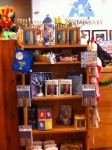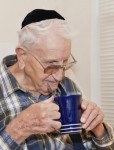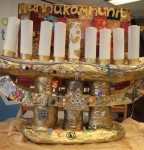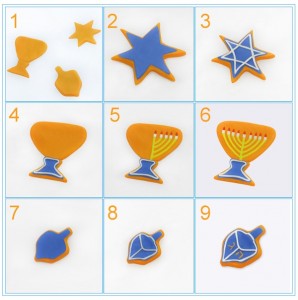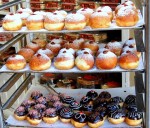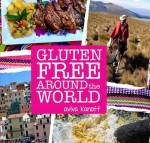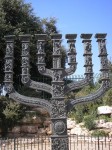Mountain Baby’s Chanukah wares on display. (photo from Judy Banfield)
For most of us, preparing for Chanukah is fairly simple. When it comes to finding candles, dreidels and even menorahs, there is no lack of stores and gift shops in Vancouver and Victoria in which to find that last-minute Chanukah item. Even online ordering seems faster these days, with delivery options that can take as little as a day or two to Canada’s West Coast.
But if you are one of the several hundred Jews who populate British Columbia’s small communities where neither stores nor outpost are likely to carry Chanukah candles let alone a chanukiyah, celebrating the Jewish Festival of Lights means not only a ton of advance planning but might even mean mapping out your prep, just short of a supply reconnaissance.
First, there’s the planning: the long-distance phone calls, the maps and, often, the overnight accommodation arrangements. Then there’s the road trip – sometimes for several days at a time. For those semi-rural residents who have moved from larger Jewish communities, said Kamloops Jewish community (1-250-372-9217 or kamloopsjewishcommunity.wordpress.com) president Heidi Coleman, planning Chanukah in the country can be an experience in itself.
“In Montreal, you didn’t really have to do so much to be Jewish because Montreal had a huge Jewish community,” said Coleman, who moved to Kamloops two years ago from the East Coast. “Here, everyone who is interested is making an effort to maintain their Judaism.”
Since Kamloops is only a four-hour drive from Vancouver (in optimum conditions), community members often travel to “the big city” to pick up their supplies. She acknowledged that, over the years, the community, which includes members in rural areas outside of Kamloops, has developed an “emergency” list of contacts to fit each holiday season, ranging from Jewish Federations of Canada-UIA in Toronto, to the Okanagan Jewish Community Centre in Kelowna. Still, she said, local stores are beginning to realize that they have a Jewish community in their midst.
“Last year, at Target in Kamloops, they had Chanukah decorations,” remarked Coleman, amazed.
Anne Zazuliak, who serves as the office administrator for the Okanagan JCC in Kelowna and runs its small gift shop (1-250-862-2305 or ojcc.ca), said they often receive customers from throughout the Okanagan and beyond. The small shop has filled a vital niche for Okanagan Jews for almost 20 years. Prior to that, said David Spevakow, the organization’s president, the community did as many rural households still do: they poured over catalogues and purchased in bulk through long-distance connections.
The Chabad Okanagan Centre for Jewish Life and Learning (1-250-862-2305) also acts as a conduit for rural Jews. The centre’s co-director, Rabbi Shmuly Hecht, said the centre does “a lot of contact all over the valley,” providing everything from “Chanukah artifacts” to tzedakah boxes and how-to guides for holiday observance. Jewish families will travel from as far as Salmon Arm, 90 kilometres away, to connect with the centre, which, like many Chabad locations, hosts Chanukah celebrations for the outlying communities.
In Nelson, a long day’s drive from Vancouver, the children’s store Mountain Baby (1-250-352-1789 or mountainbaby.com) is often the go-to place for Jewish families tucked throughout B.C.’s rugged eastern mountains. The shop is owned by Judy Banfield, and is a well-known niche for this time of year.
“I only stock Chanukah supplies,” said Banfield. Vital items like candles, dreidels and chanukiyahs can be shipped outside of Nelson and generally take a “couple of days within B.C. and Alberta” or longer for areas out of province, she said.
The Kootenay Jewish Community Association (contact is [email protected]), also in Nelson, sometimes orders other resources for its members, as well. The organization, which has members scattered throughout the Northwest, helps to connect Jews in areas far away from synagogues.
At the other end of the province, Yvette and David Freeman, who live in Qualicum Beach on Vancouver Island, travel two hours to Victoria to purchase their Jewish holiday supplies. David, who is a lawyer, and his wife Yvette, frequently travel throughout the province, and are acquainted with the challenges being Chanukah-ready in semi-rural areas.
“We always take our own supplies, whether it is kosher food, candles or wine with us. Of course, nearly every B.C. Liquor store carries Manischewitz kosher wine,” said Yvette Freeman.
“In our traveling, we find that there generally seems to be no central buying system.” Often, she said, “we are surprised to find ‘Jewish relevant’ items in some supermarkets.”
Just the same, she observed, there are now options for rural Jews that didn’t exist just a few years ago, thanks to the Internet.
“It all depends on the attitude of the person and the amount of money they are prepared to pay to maintain their level of commitment to Yiddishkeit,” Freeman said.
Jan Lee’s articles have been published in B’nai B’rith Magazine, thedailyrabbi.com and Voices of Conservative and Masorti Judaism. She also writes on sustainable business practices for TriplePundit.com. Her blog can be found at multiculturaljew.polestarpassages.com.

